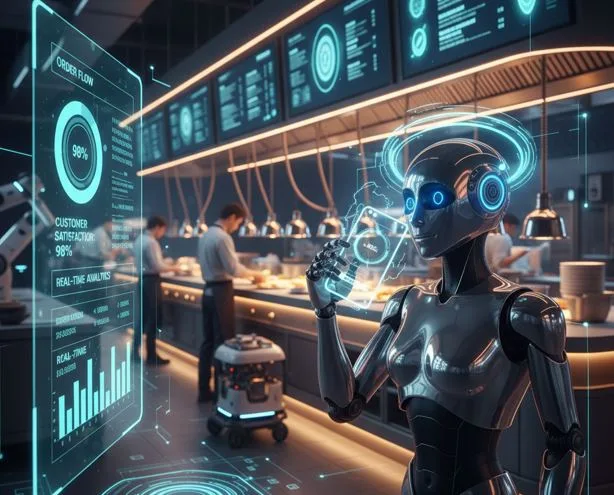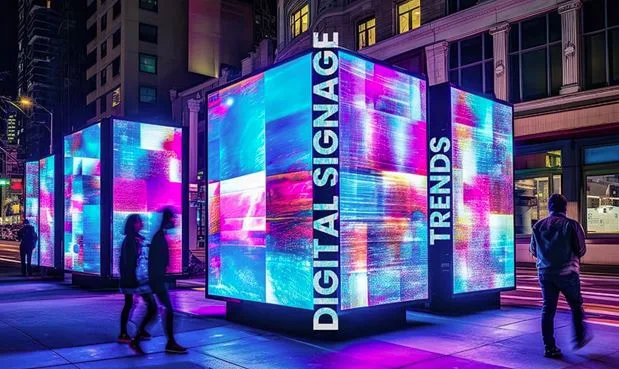How Voice AI and Vision AI Are Revolutionizing Restaurant Operations?
Imagine walking in your restaurant where orders are taken by voice, kitchens run with real-time visual checks and you identify problems even before they arise. This isn’t the future, it’s happening now! AI has become the cornerstone for several restaurants and is evolving how teams work and guests are served.
This trend has unfolded with two pillars of AI – Voice AI and Vision AI for restaurants. Voice AI listens and responds and Vision AI sees and analyzes.
- 34% of restaurants have already adapted to voice AI systems in 2025.
- These voice systems are achieving up to 95%+ accuracy in interacting with customers, such as making reservations or phone orders.
- A major restaurant chain using a vision-AI tool achieved 95% accuracy in food measurement monitoring in its kitchen workflow.
Together, these two are ushering a new era of connected, data-driven restaurants that think and act in real time.
What Is Voice AI for Restaurants?
A voice AI ordering system for a restaurant brings together advanced speech processing with restaurant operations to enhance ordering and dining experience of customers. Voice AI for restaurants places orders by drive-thru, app or smart speaker using speech recognition. It confirms orders and processes payment, routing orders to KDS.
Using voice AI, staff can directly converse like:
- What’s the status of order number 32?
- How many portions of grilled chicken are left?
- Inform the manager that table 12 has a complaint.
- Who’s responsible for closing duties today?
- Apply a 10% discount to order 23.
Benefits of Voice AI for Restaurants
Reduces order errors
The system automatically captures orders, confirms them, syncs with POS and avoids manual entry mistakes.
Increases speed and hygiene
As multiple orders are processed at the same time it leads to increased speed. These orders are hands-free reducing wait time and manual handling.
Enhances accessibility and employee productivity
As employees can focus on other tasks like guest interaction and food preparation it enhances employee productivity
What Is Vision AI for Restaurants?
Vision AI for restaurants powers automation where cameras serve as “eyes” to see and analyze restaurant operations. This may range from viewing inventory shelves, monitoring table occupancy and assessing availability of menu items like pastries or croissants. These applications utilize common security cameras without additional sensors.
With Vision AI for restaurants, you can:
- Gauge kitchen hygiene and food prep compliance.
- Utilize cameras that monitor customer queues and alert staff during peak times to speed up service.
- Identify when dishes are ready or when customers need attention.
- Monitor BOH and dining areas to detect suspicious activities or unauthorized access.
Benefits of Vision AI for Restaurants
Better efficiency and consistency
It ensures every dish meets quality standards, streamlining kitchen workflow and detecting errors in real time.
Reduces waste and improves customer experience
It tracks ingredient usage, portion size to avoid overproduction, detects spoilage early and rolls out high-quality meals to meet customer expectations.
Enables data-driven decision-making
Vision AI interprets data from the real world to analyze data from kitchen, dining spaces and inventory to uncover patterns in operations, optimize staffing and reduce inefficiencies.
Voice AI vs Vision AI: Complementary, Not Competing
| Feature | Voice AI | Vision AI |
| Input Type | Speech / Voice Commands | Visual / Camera Feeds |
| Best For | Ordering, staff efficiency and customer engagement | Monitoring, safety and compliance |
| Core Function | Understands and processes spoken interactions | Detects and analyzes visual patterns |
| Key Benefit | Availability of 24/7 support | Ensures consistency, hygiene and quality control |
| Data Collected | Audio and conversational data | Video and image data |
| Combined Power | Together, they create a complete automation ecosystem. Voice AI handles communication while Vision AI ensures execution accuracy. | |
By integrating Vision AI and Voice AI, an intelligent restaurant brain is invented that combines the power of seeing and listening. Voice AI takes orders, answers questions and updates POS.
Vision AI detects errors in plating, monitors hygiene, tracks wait times, and analyzes performance data.
Real-World Examples & Use Cases
Domino’s using Vision AI for pizza quality assurance
DOM Pizza Checker uses cameras mounted above the cutting stations to take pictures of completed pizzas before they are packaged. By comparing these pizzas against references, the checker verifies correct toppings, proper distribution and overall quality standards.
Starbucks experimenting with AI-powered voice assistants
Starbucks added voice ordering through its app using Siri and Google Assistant, allowing customers to say things like “Order my usual from Starbucks.”
Similarly, smaller restaurants are adopting affordable AI modern platforms like NOVA to make orders via Voice AI.
The NOVA Edge: AI-Native Restaurant Management
NOVA is a unified POS and restaurant management system built for AI-native efficiency. It’s built by former Tesla engineers, integrating multi-camera processing (MCP) tools with a unified data hub, automating signal analysis across restaurants. It evaluates data on customer footfall and drive-thru queues, enabling restaurants to act quickly.
It can simply use voice commands, such as “NOVA, start table cleaning checklist,” allowing Voice AI to initiate and log tasks hands-free. Simultaneously, it verifies the environment through camera feeds, confirming whether the table is vacant or properly cleaned. If something is missed, the system can prompt corrective action with a voice alert, such as “Please recheck table four.”
NOVA, as an AI-native platform, amalgamates the application of Voice AI and Vision AI to drive customer experience. It offers drive-thru and kiosk ordering where the system understands accents and sends orders directly to the POS and KDS. Staff can use commands to check inventory or get real-task reminders. On the other hand, it uses Vision AI to detect food prep delays, hygiene compliance and ensure cleanliness and consistency.
By integrating the listening power of Voice AI and visual intelligence of Vision AI, NOVA becomes a smart restaurant intelligence tool.
The Future Is Voice- and Vision-Enabled
NOVA is using Voice AI and Vision AI to transform the restaurant industry by reshaping customer experience and backend efficiency. On customer front, Voice AI fosters fast, hands-free ordering and personalized experience reducing wait time and improving accuracy. On the other hand, Vision AI ensures visual consistency in food presentation, cleanliness and service standards.
In future, NOVA will analyze historical voice and visual data to anticipate inventory shortages, forecast staffing needs and predict demand for menu items. In the coming years, the most successful restaurants won’t just run on recipes, they’ll run on recognition and response.
And this makes NOVA your single source of truth for restaurant applications.






